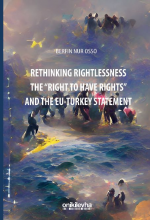 The migration "crisis" in 2015, the largest human displacement since the end of World War II, made people become aware of the existence of a "right to have rights" and a right to belong to some kind of organized community once again when the refugee who had been forced to flee his or her country of origin lost and could not regain or enjoy these rights elsewhere. This has also demonstrated that human rights indeed need a prerequisite right to be more than citizenship rights: that is the "right to have rights," which must be guaranteed by humanity itself.
Following the summer of migration in 2015, the EU and Turkey came to a deal on 18 March 2016, which is officially known as the EU-Turkey Statement. The implementation of the Statement raised concerns especially over the human rights violations it entails vis-à-vis the migrants, most of which are refugees, who are returned from the Greek islands to Turkey or who are expelled from the EU territory at the very Greek-Turkish border. Rather than "merely" depriving these people of certain set of rights enshrined in international and regional human rights instruments, the EU-Turkey Statement deprives them of a more fundamental "right to have rights" which also puts other rights in jeopardy.
While the case studies which this work is based upon are predominantly taken from mid-2015 until February 2019, it continues to help us see and understand the current situation that rightless refugees are facing at the doorsteps of the EU, within Turkey, or elsewhere in the world. This work, therefore, provides illuminating insights for people who would like to learn further about the contemporary struggles of refugees who are directly or indirectly affected by the externalization measures of the EU.(ARKA KAPAKTAN)
The migration "crisis" in 2015, the largest human displacement since the end of World War II, made people become aware of the existence of a "right to have rights" and a right to belong to some kind of organized community once again when the refugee who had been forced to flee his or her country of origin lost and could not regain or enjoy these rights elsewhere. This has also demonstrated that human rights indeed need a prerequisite right to be more than citizenship rights: that is the "right to have rights," which must be guaranteed by humanity itself.
Following the summer of migration in 2015, the EU and Turkey came to a deal on 18 March 2016, which is officially known as the EU-Turkey Statement. The implementation of the Statement raised concerns especially over the human rights violations it entails vis-à-vis the migrants, most of which are refugees, who are returned from the Greek islands to Turkey or who are expelled from the EU territory at the very Greek-Turkish border. Rather than "merely" depriving these people of certain set of rights enshrined in international and regional human rights instruments, the EU-Turkey Statement deprives them of a more fundamental "right to have rights" which also puts other rights in jeopardy.
While the case studies which this work is based upon are predominantly taken from mid-2015 until February 2019, it continues to help us see and understand the current situation that rightless refugees are facing at the doorsteps of the EU, within Turkey, or elsewhere in the world. This work, therefore, provides illuminating insights for people who would like to learn further about the contemporary struggles of refugees who are directly or indirectly affected by the externalization measures of the EU.(ARKA KAPAKTAN)
İÇİNDEKİLER
CHAPTER I
Introduction
1.1. Background
1.2. Research Objective and Research Questions
1.3. Scope of the Study
1.4. Methods and Data
1.5. Outline
CHAPTER II
On the Arendtian Critique of Human Rights
2.1. Human Rights in Political and Legal Theory
2.2. Why a "Right to Have Rights"?
2.3. The "Right to Have Rights" qua the Right to Membership in a Political Community
2.4. The "Right to Have Rights" qua the Right to Asylum
2.5. Interim Conclusion
CHAPTER III
The Law of Human Rights: Certain Safeguards in International and European Law
3.1. The Rights to Life and to Liberty in International and European Law
3.2. The Prohibition of Torture in European Law
3.3. The Prohibition of Refoulement in International and European Law
3.4. The Secondary Rights under the Refugee Convention
CHAPTER IV
Deciding "In", Acting "Out": The Externalization of Migration Management in the EU and the Turkish Asylum Regime
4.1. On the Externalization of Migration Management
4.2. The Externalization of Migration Management in the EU
4.3. The Externalization of Migration Management and the Turkish Asylum Regime
4.4. Interim Conclusion
CHAPTER V
The "Right to Have Rights" and the EU-Turkey Statement: The Two Unimaginable?
5.1. The EU-Turkey Statement from a Legal Perspective
5.2. Back to Arendt: The "Right to Have Rights" and the EU-Turkey Statement
CHAPTER VI
Conclusion: Rethinking Rightlessness
REFERENCES
